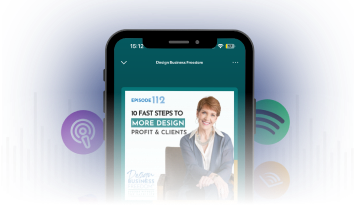How to Be Your Interior Design Client’s Superhero
In the competitive world of interior design, standing out and becoming indispensable to your clients is crucial. One of the most effective ways to do this is by positioning yourself as your client’s superhero—someone who not only solves their design problems but does so with such thoughtfulness, style and expertise that they wouldn’t dream of tackling a project without you. Let’s explore strategies for elevating client relationships in design, transforming your role from just a designer to a design superhero for your clients.
1. Let Your Clients See You Sweat
It’s tempting to always present yourself as cool, calm, and collected, assuring your clients that everything is under control. However, allowing your clients to see the effort, thought, and expertise that goes into solving their design challenges can actually enhance your value in their eyes.
When they see that some aspects of design require a high level of skill and creativity, they’ll appreciate your expertise more and realize that they could not achieve the same results on their own. This transparency is key to elevating client relationships in design.
2. Slow Down the Process to Show Your Superpowers
In your head, you might redesign a room within minutes, but it’s important not to reveal that to your clients. Instead, slow down the process and let them see that it takes time, research, and a lot of thought to come up with the best design solutions.
This doesn’t mean you should drag out the process unnecessarily, but by highlighting the careful consideration you put into each decision, you emphasize the value of your services. Slowing down is a crucial strategy for elevating client relationships in design.

3. Identify and Address Your Client’s Triggers
Clients come to you with specific pain points, even if they can’t always articulate them clearly. It’s your job to listen closely and identify these triggers. Whether it’s discomfort in a space, functional issues, or dissatisfaction with aesthetics, addressing these underlying problems is key to creating a design that truly resonates with them.
When you solve these core issues, you’re not just providing a service; you’re transforming their environment in a way that profoundly impacts their daily life. Addressing triggers is essential for elevating client relationships in design.
4. Use Strategic Communication
The way you communicate with your clients can either elevate or diminish your perceived value. Avoid using phrases that make your work seem easy or effortless, as this can give the impression that your expertise isn’t necessary. Instead, use language that emphasizes the thoughtfulness and creativity behind your solutions.
For example, instead of saying, “I’ve got this,” you might say, “This is a challenging space, but I’m excited to explore different solutions and find the one that works best for you.” Strategic communication is fundamental to elevating client relationships in design.
5. Paint a Picture of the Impact
When discussing design elements, focus on the impact they will have on your client’s life. It’s not just about choosing a sofa or selecting paint colors—it’s about creating a space where they can relax, entertain, or simply feel at peace.
By painting a vivid picture of how your design will enhance their life, you make the investment in your services feel not just necessary, but invaluable. This approach is powerful for elevating client relationships in design.
6. Address the Three Universal Problems
Every design project you take on addresses one or more of these universal problems: fitness (health), finances (status and investment), and family (relationships). Understanding which of these areas is most important to your client allows you to tailor your approach and highlight how your design will improve their life in these key areas. When clients see that your design solves significant problems, they are more likely to see the value in your services, which is key to elevating client relationships in design.
Key Takeaways
Being your client’s superhero means going beyond the basics of design to truly understand and address their needs in a way that makes them feel supported, valued, and cared for. By letting them see the thought and effort behind your work, addressing their pain points, and framing your design solutions as life-enhancing, you elevate your role from just a designer to an indispensable partner in their life. Elevating client relationships in design is not just about delivering great work—it’s about creating lasting, meaningful connections that clients will treasure.
If you’re ready to increase your interior design practice profits, work exclusively with ideal clients, and enjoy the time and resources for your extraordinary life, explore your coaching options. We’ve got your back in the business of interior design.





